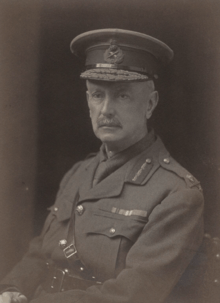James Young (British Army officer)
Major-General James Charles Young CB (1858–1926) was a British Army officer.
James Young | |
|---|---|
 Major-General James Young | |
| Born | 1858 |
| Died | 1926 |
| Allegiance | United Kingdom |
| Service/ | British Army |
| Rank | Major-General |
| Commands held | 2nd Bn, the Royal Sussex Regiment 7th Ferozepore Brigade 4th Rawalpindi Brigade Home Counties Division 2nd Home Counties Division |
| Battles/wars | Second Boer War First World War |
| Awards | Companion of the Order of the Bath |
Military career
Young was commissioned into the 35th (Royal Sussex) Regiment of Foot on 11 November 1876.[1] He saw action in the Anglo–Egyptian War in 1882 and the Nile Expedition in 1884.[2] He then became Deputy Assistant Adjutant General in South Africa in 1892 and commanding officer of the 2nd Battalion, the Royal Sussex Regiment in South Africa in 1899 and fought on the Second Boer War.[2] He went on to be Assistant Adjutant General of the 4th (Quetta) Division in 1904, commander of the 7th Ferozepore Brigade in November 1907 and commander of the 4th Rawalpindi Brigade in February 1909.[3]
After that Young became General Officer Commanding Home Counties Division in October 1912.[3] He accompanied his division on its journey, departing from Southampton on 30 October 1914 for India; however on arrival in Bombay on 1 December 1914, he handed over the units and returned to England, arriving on 22 December.[4] He took command of the 2nd Line 2nd Home Counties Division on 20 January 1915.[4] He then retired in April 1917.[4]
He was colonel of the Royal Sussex Regiment from 1914 to 1926.[5]
References
- "No. 24380". The London Gazette. 10 November 1876. p. 5963.
- "Papers of Major-General James Charles Young". West Sussex Record Office. Retrieved 11 June 2020.
- "Army Commands" (PDF). Retrieved 7 June 2020.
- Becke 1937, p. 75-82
- "The Royal Sussex Regiment". Regiments.org. Retrieved 7 December 2018.
Sources
- Becke, Major A. F. (1937). Order of Battle of Divisions Part 2B. The 2nd-Line Territorial Force Divisions (57th–69th) with The Home-Service Divisions (71st–73rd) and 74th and 75th Divisions. London: HMSO. ISBN 1-871167-00-0.CS1 maint: ref=harv (link)
| Military offices | ||
|---|---|---|
| Preceded by Charles Townshend |
GOC Home Counties Division 1912–1914 |
Succeeded by Post Disbanded |
| New title | GOC 67th (2nd Home Counties) Division 1915−1917 |
Succeeded by Cecil Bingham |